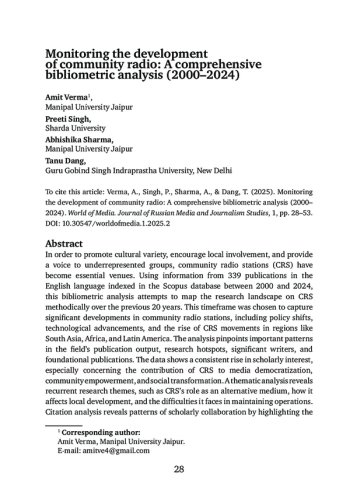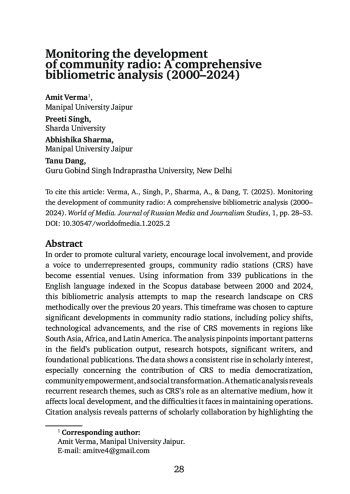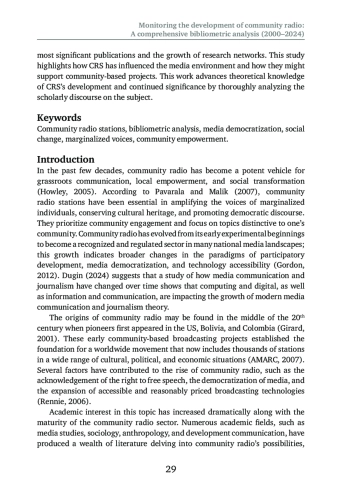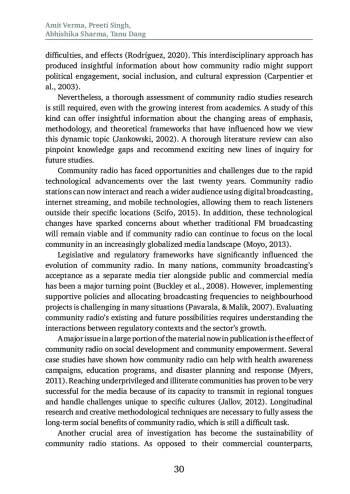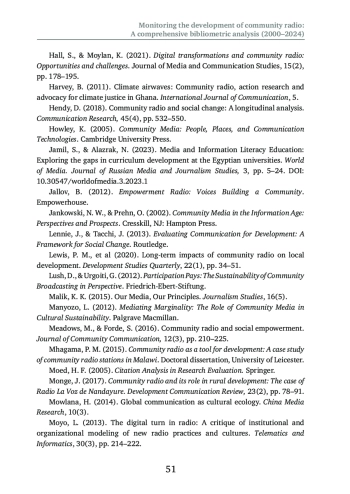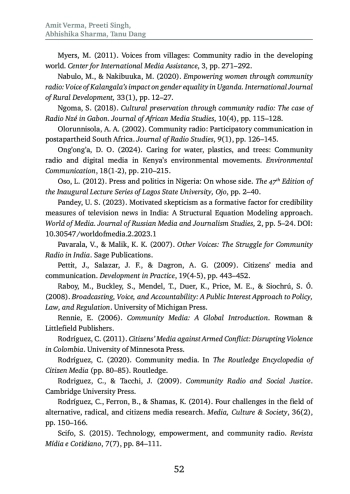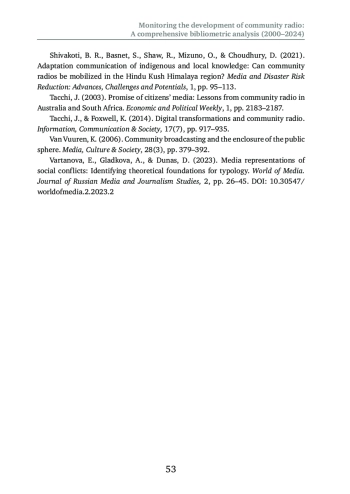In order to promote cultural variety, encourage local involvement, and provide a voice to underrepresented groups, community radio stations (CRS) have become essential venues. Using information from 339 publications in the English language indexed in the Scopus database between 2000 and 2024, this bibliometric analysis attempts to map the research landscape on CRS methodically over the previous 20 years. This timeframe was chosen to capture significant developments in community radio stations, including policy shifts, technological advancements, and the rise of CRS movements in regions like South Asia, Africa, and Latin America. The analysis pinpoints important patterns in the field’s publication output, research hotspots, significant writers, and foundational publications. The data shows a consistent rise in scholarly interest, especially concerning the contribution of CRS to media democratization, community empowerment, and social transformation. A thematic analysis reveals recurrent research themes, such as CRS’s role as an alternative medium, how it affects local development, and the difficulties it faces in maintaining operations. Citation analysis reveals patterns of scholarly collaboration by highlighting the most significant publications and the growth of research networks. This study highlights how CRS has influenced the media environment and how they might support community-based projects. This work advances theoretical knowledge of CRS’s development and continued significance by thoroughly analyzing the scholarly discourse on the subject.
Идентификаторы и классификаторы
In the past few decades, community radio has become a potent vehicle for grassroots communication, local empowerment, and social transformation (Howley, 2005). According to Pavarala and Malik (2007), community radio stations have been essential in amplifying the voices of marginalized individuals, conserving cultural heritage, and promoting democratic discourse. They prioritize community engagement and focus on topics distinctive to one’s community. Community radio has evolved from its early experimental beginnings to become a recognized and regulated sector in many national media landscapes; this growth indicates broader changes in the paradigms of participatory development, media democratization, and technology accessibility (Gordon, 2012). Dugin (2024) suggests that a study of how media communication and journalism have changed over time shows that computing and digital, as well as information and communication, are impacting the growth of modern media communication and journalism theory.
Список литературы
1. Atabek, G. S., & Atabek, Ü. (2023). Representing the guests: How Russians are portrayed in Antalya local media. World of Media. Journal of Russian Media and Journalism Studies, 2, pp. 46-63. DOI: 10.30547/worldofmedia.2.2023.3 EDN: IBTHKN
2. Abdulai, A. R., Chireh, V. K., & Tchoukaleyska, R. (2021). Engaging diverse audiences: The role of community radio in rural climate change knowledge translation. Journal of Community Engagement and Scholarship, 13(3), p. 8. EDN: PEWXJG
3. AMARC. (2007). Community radio social impact assessment: Removing barriers, increasing effectiveness. World Association of Community Radio Broadcasters.
4. Anderson, H. (2011). Community radio and cultural diversity in South Africa: The case of Bush Radio. Journal of Radio Studies, 8(1), pp. 45-62.
5. Atton, C. (2003). Alternative Media. Sage Publications.
6. Atton, C. (Ed.). (2015). The Routledge Companion to Alternative and Community Media (pp. 48-56). London: Routledge.
7. Bassar, E. (2022). Community Radio and Climate Change in Indonesia. In Sustainability Communication across Asia (pp. 148-162). Routledge.
8. Brisset-Foucault, F. (2011). Peace-making, power configurations and media practices in northern Uganda: A case study of Mega FM. Journal of African Media Studies, 3(2), pp. 205-225.
9. Carpentier, N. et al. (2017). Community Media as Communicative Figurations: Contextualizing a Changing Communication Landscape. Palgrave Macmillan.
10. Carpentier, N., Lie, R., & Servaes, J. (2003). Community media: Muting the democratic media discourse? Continuum, 17(1), pp. 51-68.
11. Castells, M. (2009). Communication Power. Oxford University Press.
12. Cottle, S. (2013). Global Crisis Reporting: Journalism in the Global Age. Open University Press.
13. Couldry, N. (2010). Why voice matters: Culture and politics after neoliberalism. Why Voice Matters, pp. 1-184.
14. Dugin, E. (2024). A “communicative turn” in the theoretical and methodological substantiation of the media system and journalism. World of Media. Journal of Russian Media and Journalism Studies, 3, pp. 5-19. 10.30547/ worldofmedia.3.2024.1. DOI: 10.30547/worldofmedia.3.2024.1 EDN: EIGGBS
15. Dunas, D., Babyna, D., Boyko, O., Filatkina, G., Gladkova, A., Gureeva, A., Salikhova, E., Tolokonnikova, A., Vartanov, S., & Vyugina, D. (2024). Social media discourse among youth in Russia: Between Western hegemonic ambitions and struggle for traditional values. World of Media. Journal of Russian Media and Journalism Studies, 3, pp. 21-35. DOI: 10.30547/worldofmedia.3.2024.2. EDN: CVRSKP
16. Downing, J. D. (2000). Radical Media: Rebellious Communication and Social Movements. Sage. DOI: 10.30547/worldofmedia.3.2024.2Downing
17. Ewart, J. (2017). The impact of digital convergence on community radio engagement. Media Studies Journal, 20(3), pp. 211-228.
18. Fairbairn, J. (2009). Community Media Sustainability Guide: The Business of Changing Lives. Arcata, CA: Internews Network.
19. Foxwell, K. (2017). Sounds like a whisper: Australian Community Broadcasting hosts a quiet revolution. Westminster Papers in Communication and Culture, 5(1).
20. Gaynor, N., & O’Brien, A. (2017). Community radio, democratic participation, and the public sphere. Irish Journal of Sociology, 25(1), pp. 29-47.
21. Girard, B. et al (2015). Community Radio: Amplifying Marginalized Voices.Routledge.
22. Girard, W. B. (2001). A Passion for Radio: Radio Waves and Community. Comunica.
23. Gordon, J. (2015). The economic tensions faced by community radio broadcasters. In The Routledge Companion to Alternative and Community Media (pp. 247-257). Routledge.
24. Gordon, J. (Ed.). (2012). Community Radio in the Twenty-First Century. Peter Lang.
25. Grove, K. (2020). The role of community radio in promoting social inclusion and empowerment in Myanmar. Asian Media Studies, 12(3), pp. 45-62.
26. Hall, S., & Moylan, K. (2021). Digital transformations and community radio: Opportunities and challenges. Journal of Media and Communication Studies, 15(2), pp. 178-195.
27. Harvey, B. (2011). Climate airwaves: Community radio, action research and advocacy for climate justice in Ghana. International Journal of Communication, 5.
28. Hendy, D. (2018). Community radio and social change: A longitudinal analysis. Communication Research, 45(4), pp. 532-550.
29. Howley, K. (2005). Community Media: People, Places, and Communication Technologies. Cambridge University Press.
30. Jamil, S., & Alazrak, N. (2023). Media and Information Literacy Education: Exploring the gaps in curriculum development at the Egyptian universities. World of Media. Journal of Russian Media and Journalism Studies, 3, pp. 5-24. DOI: 10.30547/worldofmedia.3.2023.1 EDN: MWSEQB
31. Jallov, B. (2012). Empowerment Radio: Voices Building a Community. Empowerhouse.
32. Jankowski, N. W., & Prehn, O. (2002). Community Media in the Information Age: Perspectives and Prospects. Cresskill, NJ: Hampton Press.
33. Lennie, J., & Tacchi, J. (2013). Evaluating Communication for Development: A Framework for Social Change. Routledge.
34. Lewis, P. M., et al (2020). Long-term impacts of community radio on local development. Development Studies Quarterly, 22(1), pp. 34-51.
35. Lush, D., & Urgoiti, G. (2012). Participation Pays: The Sustainability of Community Broadcasting in Perspective. Friedrich-Ebert-Stiftung.
36. Malik, K. K. (2015). Our Media, Our Principles. Journalism Studies, 16(5). Manyozo, L. (2012). Mediating Marginality: The Role of Community Media in Cultural Sustainability. Palgrave Macmillan.
37. Meadows, M., & Forde, S. (2016). Community radio and social empowerment. Journal of Community Communication, 12(3), pp. 210-225.
38. Mhagama, P. M. (2015). Community radio as a tool for development: A case study of community radio stations in Malawi. Doctoral dissertation, University of Leicester.
39. Moed, H. F. (2005). Citation Analysis in Research Evaluation. Springer.
40. Monge, J. (2017). Community radio and its role in rural development: The case of Radio La Voz de Nandayure. Development Communication Review, 23(2), pp. 78-91. Mowlana, H. (2014). Global communication as cultural ecology. China Media Research, 10(3).
41. Moyo, L. (2013). The digital turn in radio: A critique of institutional and organizational modeling of new radio practices and cultures. Telematics and Informatics, 30(3), pp. 214-222.
42. Myers, M. (2011). Voices from villages: Community radio in the developing world. Center for International Media Assistance, 3, pp. 271-292.
43. Nabulo, M., & Nakibuuka, M. (2020). Empowering women through community radio: Voice of Kalangala’s impact on gender equality in Uganda. International Journal of Rural Development, 33(1), pp. 12-27.
44. Ngoma, S. (2018). Cultural preservation through community radio: The case of Radio Nzé in Gabon. Journal of African Media Studies, 10(4), pp. 115-128.
45. Olorunnisola, A. A. (2002). Community radio: Participatory communication in postapartheid South Africa. Journal of Radio Studies, 9(1), pp. 126-145.
46. Ong’ong’a, D. O. (2024). Caring for water, plastics, and trees: Community radio and digital media in Kenya’s environmental movements. Environmental Communication, 18(1-2), pp. 210-215. EDN: IZDFNU
47. Oso, L. (2012). Press and politics in Nigeria: On whose side. The 47th Edition of the Inaugural Lecture Series of Lagos State University, Ojo, pp. 2-40.
48. Pandey, U. S. (2023). Motivated skepticism as a formative factor for credibility measures of television news in India: A Structural Equation Modeling approach. World of Media. Journal of Russian Media and Journalism Studies, 2, pp. 5-24. DOI: 10.30547/worldofmedia.2.2023.1 EDN: CKLQYQ
49. Pavarala, V., & Malik, K. K. (2007). Other Voices: The Struggle for Community Radio in India. Sage Publications.
50. Pettit, J., Salazar, J. F., & Dagron, A. G. (2009). Citizens’ media and communication. Development in Practice, 19(4-5), pp. 443-452.
51. Raboy, M., Buckley, S., Mendel, T., Duer, K., Price, M. E., & Siochrú, S. Ó. (2008). Broadcasting, Voice, and Accountability: A Public Interest Approach to Policy, Law, and Regulation. University of Michigan Press.
52. Rennie, E. (2006). Community Media: A Global Introduction. Rowman & Littlefield Publishers.
53. Rodríguez, C. (2011). Citizens’ Media against Armed Conflict: Disrupting Violence in Colombia. University of Minnesota Press.
54. Rodríguez, C. (2020). Community media. In The Routledge Encyclopedia of Citizen Media (pp. 80-85). Routledge.
55. Rodriguez, C., & Tacchi, J. (2009). Community Radio and Social Justice. Cambridge University Press.
56. Rodríguez, C., Ferron, B., & Shamas, K. (2014). Four challenges in the field of alternative, radical, and citizens media research. Media, Culture & Society, 36(2),pp. 150-166.
57. Scifo, S. (2015). Technology, empowerment, and community radio. Revista Mídia e Cotidiano, 7(7), pp. 84-111.
58. Shivakoti, B. R., Basnet, S., Shaw, R., Mizuno, O., & Choudhury, D. (2021). Adaptation communication of indigenous and local knowledge: Can community radios be mobilized in the Hindu Kush Himalaya region? Media and Disaster Risk Reduction: Advances, Challenges and Potentials, 1, pp. 95-113.
59. Tacchi, J. (2003). Promise of citizens’ media: Lessons from community radio in Australia and South Africa. Economic and Political Weekly, 1, pp. 2183-2187.
60. Tacchi, J., & Foxwell, K. (2014). Digital transformations and community radio. Information, Communication & Society, 17(7), pp. 917-935.
61. Van Vuuren, K. (2006). Community broadcasting and the enclosure of the public sphere. Media, Culture & Society, 28(3), pp. 379-392. EDN: JOKNJT
62. Vartanova, E., Gladkova, A., & Dunas, D. (2023). Media representations of social conflicts: Identifying theoretical foundations for typology. World of Media. Journal of Russian Media and Journalism Studies, 2, pp. 26-45. 10.30547/ worldofmedia.2.2023.
Выпуск
Другие статьи выпуска
The article aims to outline bloggings as a complex social phenomenon and identify the current role of blogs in virtual reality. The literature review revealed that the evolving paradigm of civilizational growth has led to a hybrid environment, which combines the aspects of physical world and virtual reality artefacts, resulting in a unique media landscape, significantly impacting sociocultural and communicative dynamics. However, the field lacks studies on typical features of blogosphere, such as its inherent openness, fostering informal communication, intention to both monetization and self-expression. To address the study’s objectives the research adopts an integrative interdisciplinary approach, including socio-philosophical and semiotic cultural studies, theory of computer communication, network and Internet discourse studies to use data from various fields of humanitarian knowledge. It is concluded that originally created as online diaries, currently blogs as a diverse media platform demonstrate several unique features, including high personalization, audience feedback capabilities, constant user engagement with various types of information (verbal, audial, visual). These characteristics positioned blogs as key contributors to the growth of virtual sociality, leading to the emergence of a new type of society characterized by heightened human sensory experiences and the development of new empathetic models and behavioral attitudes. A notable sign of these changes is that the audience’s attention has shifted from professional media institutions to individual bloggers, who are increasingly adopting media-like behaviors. The current research adopts an interdisciplinary approach, merging socio-philosophical and semiotic cultural studies, as well as with theory of computer communication, network and Internet discourse studies. It also employs methods of Internet linguistics and the principles of pragmalinguistics; the axiological method helps to identify value-based sociocultural guidelines within the framework of globalization.
This study aims to investigate the impact of avatar identification on the intention to share by examining the mediating role of user immersion and the moderating effect of perceived social distance. For this, we collected 228 higher education students in South Korea through a survey and used hierarchical regression with SPSS 24.0. In the results, first, it showed that participants who perceived higher levels of similarity identification, wishful identification, and embodied presence in their avatars in the metaverse platform were more immersed in their avatars. Second, participants who perceived greater embodied presence in their avatars had a stronger intention to share their avatars through immersion. Finally, the positive relationship between perceived embodied presence and immersion was more significant for participants in metaverse platforms with higher perceived social distance compared to those with lower perceived social distance. This study is the first to examine the integral model of avatar identification factors in the metaverse platform. And, this study’s results show the mechanism by which avatar identification enhances the intention to share.
“Femvertising”, advertising that adopts the perspective of females, has become a popular global marketing strategy. Some Chinese brands are adopting it in their marketing communication. However, studies on audience response to femvertising mainly focus on Western consumers. Relevant research studies, particularly those with young consumers, are still scarce in China. This qualitative study aims to fill the research gap and examine young consumers’ responses to femvertising and its perceived effectiveness. Focus group interviews were conducted in March 2023 with three groups comprising female university students, male university students, and working females aged 20 to 25. The results showed that participants paid much attention to the advertising execution style and storytelling skills of femvertising. Liking of a specific feminist advertisement would enhance the brand image. However, a brand’s historical portrayal of female influences the communication effectiveness of its femvertising. An abrupt adoption of femvertising creates doubts and reservations. Female and male participants had different attitudes toward femvertising. As expected, female participants showed more appreciation of femvertising than male participants.
Статистика статьи
Статистика просмотров за 2025 год.
Издательство
- Издательство
- МГУ
- Регион
- Россия, Москва
- Почтовый адрес
- оссийская Федерация, 119991, Москва, Ленинские горы, д. 1
- Юр. адрес
- оссийская Федерация, 119991, Москва, Ленинские горы, д. 1
- ФИО
- Садовничий Виктор Антонович (РЕКТОР)
- E-mail адрес
- info@rector.msu.ru
- Контактный телефон
- +7 (495) 9391000
- Сайт
- https://msu.ru/
